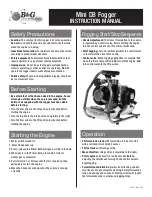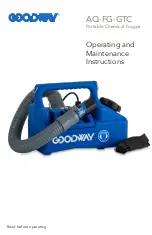
OPERATION AND MAINTENANCE
4-7
Tractor Preparation
The Landoll 9650FH Field Cultivator is designed to be
pulled by tractor equipped with a double lip or clevis type
hitch. If your tractor is not equipped as such, you need to
purchase the hitch from your local tractor dealer. Before
attaching the Field Cultivator, prepare the tractor as
follows:
1.
Inflate the rear tractor tires equally and add ballast
according to the tractor operator’s manual.
2.
Lock the tractor drawbar in the center position.
Prior to Transport
1.
Use a locking style hitch pin that properly fits the
holes in the tractor drawbar and implement hitch.
2.
Attach safety chain.
3.
Plug in safety lights to the tractor seven-pin
connector.
4.
Raise the implement parking jack and place in the
field storage position.
5.
Make sure all transport locks and pins are installed.
Do not depend solely on implement hydraulics for
transport.
6.
Check that tires are of proper size, load rating, and
inflated to manufacture specifications before
transporting. Check wheel lug bolts to insure
tightness.
7.
Know the transport heights and widths of the unit
before transporting. Attachments such as leveling
harrows can increase the transport dimensions of the
implement. Use caution when transporting near
bridges and power lines.
DANGER
8.
Verify that all warning lights, SMV sign, reflectors and
safety decals are clearly visible and functioning
properly. Remove any obstructions such as dirt, mud,
stalks or residue that restricts view before
transporting.
9.
Transport during daylight hours whenever possible.
Always use flashing warning lights, except where
such use is prohibited by law.
Leveling (Side to Side)
1.
Leveling the Field Cultivator side-to-side involves
leveling the center frame then leveling the wing
frames to the center frame. The unit should be level
side-to-side when operating in the field.
2.
To level the unit, verify that all tires are properly
inflated. With the implement unfolded, raise the unit
to fully extend the lift cylinders. Continue to hold the
tractor lever 30-60 seconds to insure that the
cylinders are fully extended and the rephasing lift
system has been purged of air. Lower the implement
until the sweeps are approximately 1” off the ground.
On the center frame, lay a straight-edge across the
top of the frame, and measure the distance from the
walking tandem spindle to the top side of the frame of
both walking tandems
Adjust the
center radius rod at the front of the Field Cultivator
center frame until the spindle heights are the same.
NOTE
Initially the center frame radius rods should be set to 54”
centers before final leveling.
3.
To adjust the radius rod’s, loosen the 1-3/4” locking
nut against the radius rod tube. Adjust the screw
adjustment in or out to the desired setting. An
adjusting wrench is provided to make this
adjustment. It may be necessary to lower the Field
Cultivator to the ground and relieve weight on the lift
arms to make this adjustment. If the cultivator has
been lowered for adjustments, fully raise the
implement, lower to just above the ground, and
re-verify measurements. Repeat as necessary and
securely tighten the 1-3/4” locking nut when
complete.
4.
Measure the same distance on the wing frame. The
wing frames are generally set 1” higher than the
center frame due to difference in tire diameter.
Adjusting the radius rod of each wing frame sets wing
frame height.
NOTE
Initially the wing frame radius rods should be set to 53”
centers before final leveling.
Stay away from power lines when transporting,
extending or folding implement. Electrocution
can occur without direct contact.
Summary of Contents for 9650FH
Page 15: ...STANDARD SPECIFICATIONS 2 7 Table provided for general use NOTES ...
Page 19: ...STANDARD SPECIFICATIONS 2 11 Table provided for general use NOTES ...
Page 23: ...STANDARD SPECIFICATIONS 2 15 Table provided for general use NOTES ...
Page 27: ...STANDARD SPECIFICATIONS 2 19 Table provided for general use NOTES ...
Page 31: ...STANDARD SPECIFICATIONS 2 23 Table provided for general use NOTES ...
Page 35: ...STANDARD SPECIFICATIONS 2 27 Table provided for general use NOTES ...
Page 39: ...STANDARD SPECIFICATIONS 2 31 Table provided for general use NOTES ...
Page 43: ...STANDARD SPECIFICATIONS 2 35 Table provided for general use NOTES ...
Page 47: ...STANDARD SPECIFICATIONS 2 39 Table provided for general use NOTES ...
Page 51: ...STANDARD SPECIFICATIONS 2 43 Table provided for general use NOTES ...
Page 55: ...STANDARD SPECIFICATIONS 2 47 Table provided for general use NOTES ...
Page 59: ...STANDARD SPECIFICATIONS 2 51 Table provided for general use NOTES ...
Page 63: ...STANDARD SPECIFICATIONS 2 55 Table provided for general use NOTES ...
Page 67: ...STANDARD SPECIFICATIONS 2 59 Table provided for general use NOTES ...
Page 71: ...STANDARD SPECIFICATIONS 2 63 Table provided for general use NOTES ...
Page 75: ...STANDARD SPECIFICATIONS 2 67 Table provided for general use NOTES ...
Page 79: ...STANDARD SPECIFICATIONS 2 71 Table provided for general use NOTES ...
Page 83: ...STANDARD SPECIFICATIONS 2 75 Table provided for general use NOTES ...
Page 87: ...STANDARD SPECIFICATIONS 2 79 Table provided for general use NOTES ...
Page 91: ...STANDARD SPECIFICATIONS 2 83 Table provided for general use NOTES ...
Page 95: ...STANDARD SPECIFICATIONS 2 87 Table provided for general use NOTES ...
Page 115: ...ASSEMBLY INSTRUCTIONS 3 17 Table provided for general use NOTES ...
Page 118: ...3 20 F 1090 1120 ASSEMBLY INSTRUCTIONS Table provided for general use NOTES ...
Page 122: ...3 24 F 1090 1120 ASSEMBLY INSTRUCTIONS Table provided for general use NOTES ...
Page 126: ...3 28 F 1090 1120 ASSEMBLY INSTRUCTIONS Table provided for general use NOTES ...
Page 130: ...3 32 F 1090 1120 ASSEMBLY INSTRUCTIONS Table provided for general use NOTES ...
Page 135: ...ASSEMBLY INSTRUCTIONS 3 37 Table provided for general use NOTES ...
Page 151: ...OPERATION AND MAINTENANCE 4 3 Table provided for general use NOTES ...
Page 163: ...OPERATION AND MAINTENANCE 4 15 Table provided for general use NOTES ...
















































